When you start looking for your next, or even your first kayak, you want to ensure you get something that fits your needs perfectly.
They come in such a huge range of designs, sizes, capabilities, and uses it’s always a little overwhelming to know which is the ideal one for you. Some are even foldable, like the Oru we reviewed previously.
I love the huge range of kayaks available these days. It means that you can get into the sport no matter your budget, space, or desire.
I think there are a few better ways to enjoy the water than this. Lakes, open seas, rivers, and harbors all become your playground with a fantastic kayak.
Inflatable Kayak Vs Hardshell
Hardshell kayaks used to be the only way to go until quite recently. Inflatable dinghies and similar crafts were available, but commercially available inflatable yaks weren’t big on the market.
Hard shell kayaks are heavy-duty and made of durable materials; they’re relatively lightweight and very streamlined. The issue lies with transport. You need a car roof rack to get it around, and they take up a lot of storage space.
Inflatable yaks have made the sport much more accessible. Being able to pack down and transport your kayak in a carry bag, and stash it away in a cupboard, means anyone can get involved.
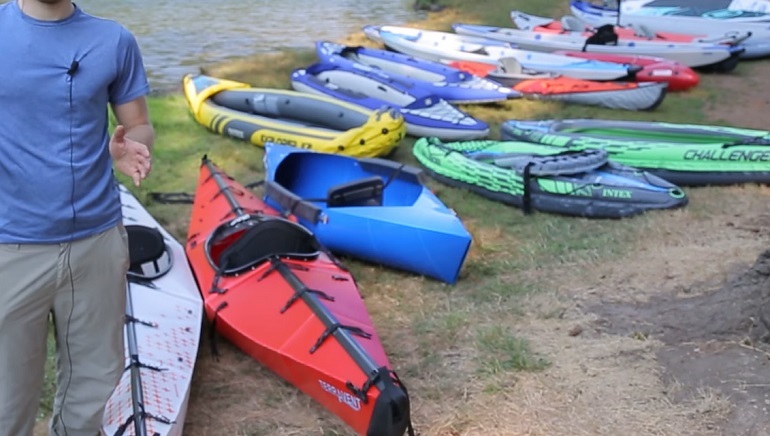
I suffer from the problem of no roof racks and a small apartment, so the old inflatable kayak is the one for me. At least, unless I can hire a hardshell kayak.
But who wins in the hardshell vs inflatable kayak debate? I’ll break it down for you so you can make your own informed decision.
A Comparison Between Hardshell Kayaks & Inflatable Kayaks
There are a lot of similarities between the two styles of kayaks, although I would never say one is imitating the other. They both serve a similar purpose but focus on their own strengths and play on them.
Use, Intent, & Water Conditions
These are the core of what you should think about when buying a hard shell or an inflatable kayak.
Use
One of the best things about a kayak, I think, is its versatility. They’re suitable for a huge range of water activities such as fishing, whitewater rafting, camping trips, and even surfing if you’re feeling extra brave.
Generally speaking, for most specialist craft, for instance, fishing kayaks, I would recommend a hardshell kayak. They have much more space for things like equipment rails and plenty of options for customization, like adding a kayak fish finder.
Rigid kayaks are also much more streamlined and lower in the water, making them faster and more stable in strong currents.
If you simply want to use your kayak for recreational use on flat water or take a lot of luggage and a paddling buddy out, the inflatable kayak is a no-brainer. The buoyancy lends itself to a higher weight capacity. You sacrifice speed for more weight capacity.
Intent
If you intend to only pop out to the water once or twice during the summer vacation, then an inflatable kayak is the choice for you. They often come with a lower price tag than their hard-shell counterparts.
It makes sense not to spend a fortune on something you’re not going to be in every day. They will be more than adequate for the trips you intend to take.
If you’re a more avid paddler, a hardshell kayak is the one for you. Hardshell kayaks cost more and take a little more maintenance, but they have the technology and design to fit your particular need.
I presume if you are out often, you will want a kayak specialized to a purpose. Hard shells can cater much more to particular styles.
Conditions
There are inflatable yaks out there that can handle chop and wake, but in general, the lowdown sitting position of a hardshell kayak offers much more stability. In addition, the lower keel and center of gravity are perfect for rough waters.
If the water is calm and the weather blissful, then an inflatable kayak is a great choice. They allow a lot of freedom of movement and often have wide-open cockpits to keep the breeze coming in.
Materials & Construction
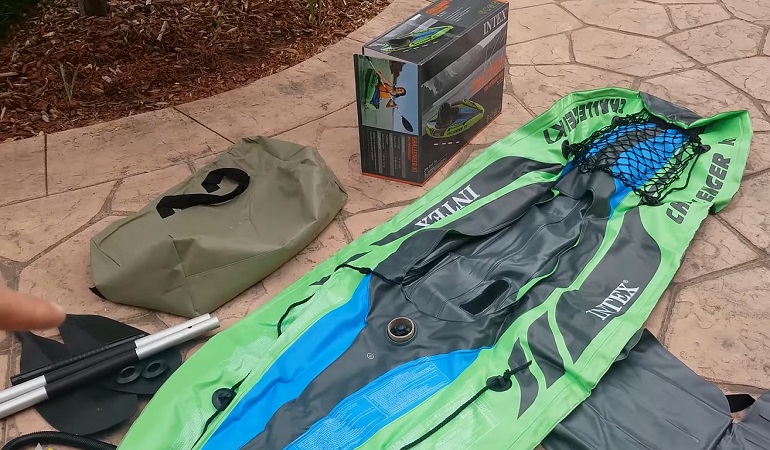
I think most people would presume that the heavy-duty construction of a hardshell kayak would be more durable than their inflatable counterparts. This isn’t always the case. High-quality inflatable kayaks are constructed from materials designed for durability and are usually highly resistant to punctures.
Inflatable kayaks are often made of multi-layered PVC and other composite materials such as synthetic rubber. The implementation of drop stitch technology and carbon fiber reinforcement throughout the frames of inflatable kayaks not only reduces the inflatable kayak’s weight but increases how resilient they become.
Hardshell kayaks are usually constructed from fiberglass, wood, plastic polymers, and other composite materials. These all maintain a rigid kayak shape but can be cumbersome.
The benefits include less maintenance, improved maneuverability, and durability. The most common material used is fiberglass due to its low weight.
Transportation & Storage
This is the big decider when choosing an inflatable kayak Vs hardshell kayak. For me, getting my kayak to and from the water isn’t as easy as throwing it on a roof rack. It needs to fit in a small space, like the trunk of my car. I also need to take into consideration how much weight I am going to have to carry.

I love hardshell kayaks, but unless I can hire one at the water I am visiting, I don’t really have the means to transport or store traditional kayaks. The beauty of an inflatable kayak is the ability to pack it down into a carrying bag and take it wherever you want to go.
If you’re lucky enough to have storage space like a garage or shed and a roof rack on your vehicle, you can afford the benefits of an assembled hardshell boat. You can load up your car for vacation and leave your trunk free for a suitcase.
Onboard Storage
The contents inflatable kayaks can carry are, in general, higher than their hard shell counterparts. This is because the nature of an inflatable boat offers the highest weight capacity. A large inflatable kayak can hold up to 750 lbs.
The inflatable kayaks will have plenty of space for storage. Open cockpits, storage compartments, and deep walls make chucking a duffle bag or suitcase into the inflatable boats’ hull worry-free. Canoes are also a great choice if you need a wide-open cockpit.

Of course, some inflatable kayaks are closed cockpits and offer very little storage compared to a hard-shell kayak. They still have a high weight capacity but much less room for storage. So these aren’t the best for paddling with cargo.
Hardshell kayaks often come equipped with excellent storage space. Sit-on-top style kayaks come with large bungee rigging on their hard surfaces. Sit-inside kayaks utilize the small space of the hardshell boat to add rigging and sealed containers that can keep your luggage completely dry.
Performance: Speed & Maneuverability
In the inflatable Vs hardshell kayak debate, the latter takes the award for speed and maneuverability. The rigid frame, good shape, and low center of gravity make paddling a lot easier than inflatable boats.

Inflated synthetic rubber will always sit higher on the water than fiberglass or plastic polymers. Being lower in the water gives you much more ability to cut through quickly and throw your body into turns.
Whitewater is completely out of the question with most inflatable kayaks but can be achieved by many hard-shell kayaks.
Rigid kayaks often have a much slimmer profile making them more streamlined and easy to move around. The issue with an inflatable kayak is how broad it is. Pushing the water around the kayak requires a lot more work.
Weight: Inflatable Kayak Vs Hardshell Kayak
The inflatable kayak takes the award for the lightest craft every time. Even if the hardshell kayaks are made of lightweight fiberglass, the synthetic rubber of an inflatable kayak will always be lighter. This is one of the reasons I like them so much.
Hardshell kayaks can weigh a lot, making them difficult to transport and get onto your car or into the water. Even with an inflatable kayak inflated, it can be easily carried to the water.
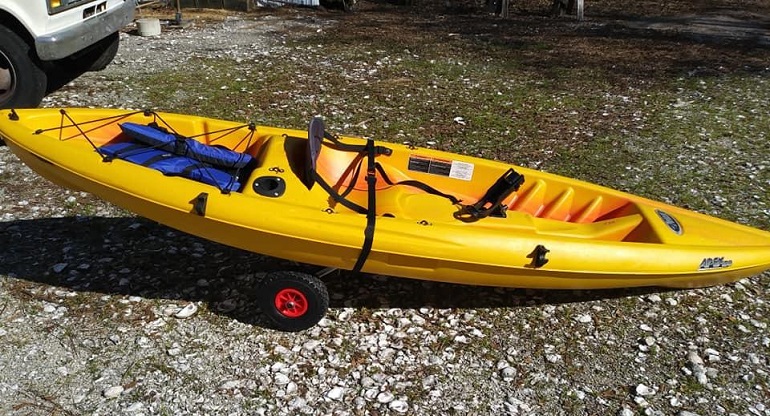
I personally don’t want to be burning all my precious arm energy, lugging around a heavy watercraft before I’ve even got to the paddling.
If lifting and shifting your kayak is going to be a problem, then get yourself an inflatable kayak. They are much easier to get from A to B than the heavy-duty construction of a hard shell kayak.
What Can They Hold in Terms of Capacity
Inflatable kayaks, in general, can hold more weight and capacity than hard-shell kayaks. The size of inflatable kayaks tends to leave more room around the paddler. They often have open cockpits and plenty of space on the deck.
This isn’t always the case. I have seen many sit-inside inflatable boats with the paddler right inside the inflatable kayak. This leaves almost no room for storage at all except a few bits of bungee rigging.
If you want a hard-shell kayak with good storage capacity, I would look for a sit-on-top or a comfortable touring kayak. With a sit-on-top kayak, the rigid frame sits almost like a platform on the water.
The whole surface of the hard kayak can be used to store cargo, often having dry compartments for electronics and valuables. However, it is common to see sit-on-top hard-shell kayaks used for fishing due to their rails for accessories. They are similar to paddle boards, but which is best?
The best sit-in hard-shell kayaks will come with bungee rigging, rails, and dry storage tubs on the bow and stern. The lower weight capacity will obviously limit your load, but you should have adequate space.
If you want to go for a long trip with a lot of cargo, such as coolers and camping equipment, a higher-quality inflatable kayak will be perfect. Make sure it has a lot of space on the bow and stern to store everything. Good size inflatable kayaks can hold more than enough for a multi-day trip.
Onboard Seating & Comfort
I have ridden some uncomfortable kayaks in my time. They have plastic and non-adjustable seats and offer almost no comfort in the kayak. If you’re planning on going out for any amount of time, you’re going to notice the benefits of a comfortable seat.
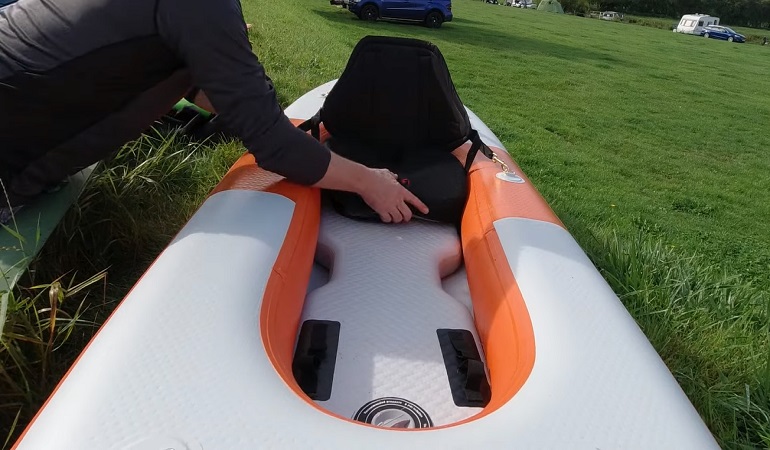
In the inflatable vs hardshell debate, it doesn’t really come down to one versus the other. They can both come with impressive seating or an absolutely dreadful one. In general, I find inflatable seats the preferable choice. These can come with both hard shells and inflatable kayaks.
For me, when it comes down to hardshell vs inflatable seats, the latter wins every time. Hard plastic seats offer more durability and are often manufactured with padding and other comfortable materials.
But I simply prefer the feeling of a padded seat and that it can be deflated, cleaned, and removed of any mold.
Whatever you decide to choose, make sure your seating is adjustable, provides support in the places you need it, and is made of durable materials.
Hardshell Vs Inflatable Stability
An inflatable kayak usually provides better stability on flat water than a hard shell kayak. This is simply due to its increased buoyancy, extra wide frame, and a flatter base. So if you plan a trip out on a calm lake or harbor, the inflatable kayak wins every time.
For a beginner kayak learning on flat water, the inflatable kayak is a perfect choice. They are forgiving and will make balancing very easy.

A hard shell kayak takes the prize as soon as you head into rough waters. Paddling through chop and waves needs a low center of gravity and a deeper keel that you simply won’t get from an inflatable kayak.
Hard shells require a little more practice to learn to balance, but for experienced kayakers, much rougher water is available.
Maintenance of A Hardshell Vs Inflatable Kayak
Proper care of your kayak is critical to ensure you get a long life from your purchase. Your kayak will sometimes require repairs, so making sure you have a repair kit as one of your accessories is essential.
Kayaks will need maintenance once out of the water. If you don’t dry them off, they will develop mold and lose structural integrity. In addition, you will have to check the hulls for dangerous scuffs and scrapes, and with inflatable kayaks, you will need to make sure the valves are still airtight.
Hardshell kayaks require more maintenance than inflatable kayaks. It takes a bit more work to empty out their hulls of water, and moving them around can be a struggle.

If you need to repair the hull of a hard kayak, you will need to spend a lot more on the patching. It will usually have to be done by a specialist, or you will need to purchase specific repair tools.
Inflatable kayaks often come with a quick repair kit that can easily patch holes. Repatching usually just requires some polyethylene and glue.
They can be quickly deflated and dried. You can even hang an inflatable kayak like a piece of laundry in the sun. You won’t have to purchase a lot of expensive tools to maintain an inflatable kayak.
Hard shell kayaks Vs Inflatable Kayaks Cost
In most cases, hardshell kayaks cost more than inflatable kayaks. This is simply due to the price of the materials used in construction. Wood, plastics, and fiberglass cost a lot more than the rubbers used in an inflatable kayak.
Of course, you can get inflatable kayaks worth thousands, but they will be top-of-the-range models with all the bells and whistles.
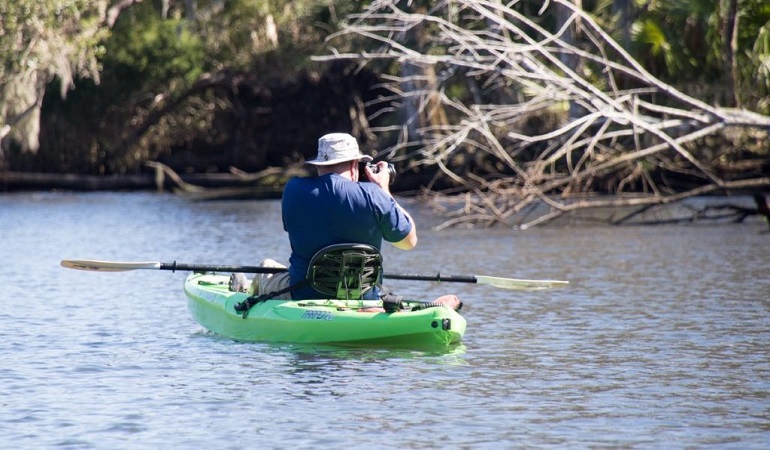
The Pros & Cons of Inflatable Vs Hard Shells
Here is a quick summary of the benefits and cons of both types of kayaks.
Hard Shell Kayaks Pros
Stability in rough water, multi-faceted use, and speed and maneuverability are where hard shells take the prize. They are designed for so many more types of water than inflatable kayaks.
They are also very durable and can take some abuse before they become damaged.
Hard Shell Kayak Cons
The cost of a hardshell boat is always higher. This makes them slightly unrealistic for the casual paddler. Transport and storage also make them unreasonable for anyone unwilling to invest in space and transfer methods.
Inflatable Kayak Pros
An inflatable kayak can be deflated and transported in a backpack to whatever remote body of water you desire. This is a huge benefit. Nowhere is out of reach.
The durable materials and amazing stability on flat water make them the obvious choice over a hard kayak for beginners and anyone who wants to take a load of cargo.
Inflatable Kayaks Cons
Compared to a hardshell boat, you’re losing out on the ability to ride whitewater, waves, and fast-moving currents. They don’t have the versatility of the hard shell. If you want speed and quick turns, you’re going to be disappointed
Hardshell Vs Inflatable – Which is Best?
This is entirely down to the intended use, budget, and destination of you, the chosen paddler. An inflatable kayak is best for the casual user who wants to easily transport their kayak to the water for some fishing or a joint trip out.
If you want to get really involved in white water or other crazy activities, have the waterside storage or a vehicle for transport, then get yourself a hard shell kayak. A hard shell is made of durable materials and a specialized design that can be used every day.
My Final Thoughts
I love kayaking. Getting out there on a lake or river is my way of unwinding or letting off steam.
For me, the inflatable kayak takes the cake simply for its cost, ease of transport, and heavy load. I like to load up with a kayak cooler, fishing gear, and a friend and spend quality time on the water.
This being said, I have often hired a hard shell for days on the surf or in the river’s rapids. Nothing beats the excitement and speed of a solid hardshell boat.
Get out there, give them both a go, and stay safe, paddlers!
0 Comments